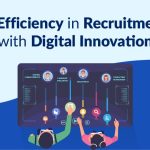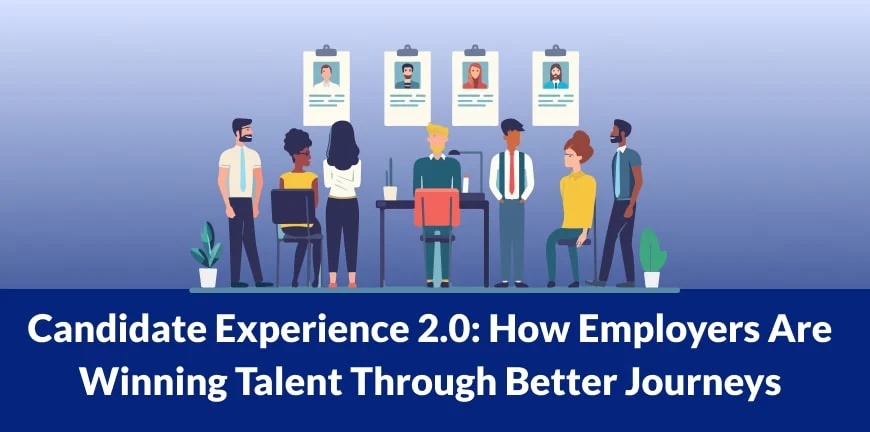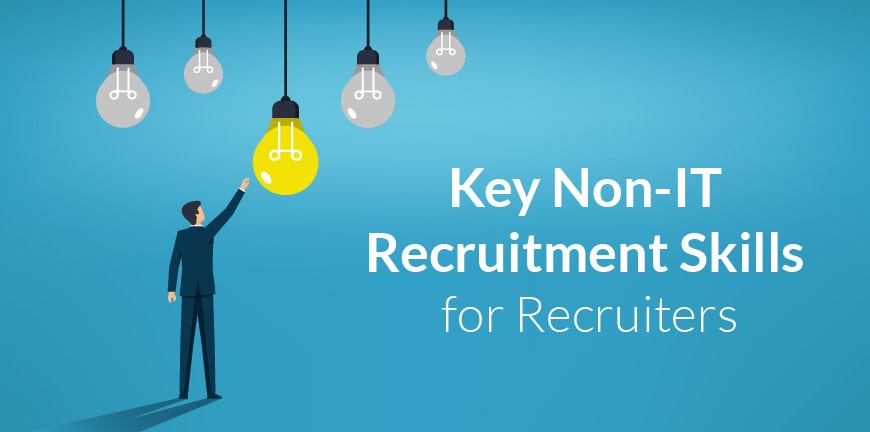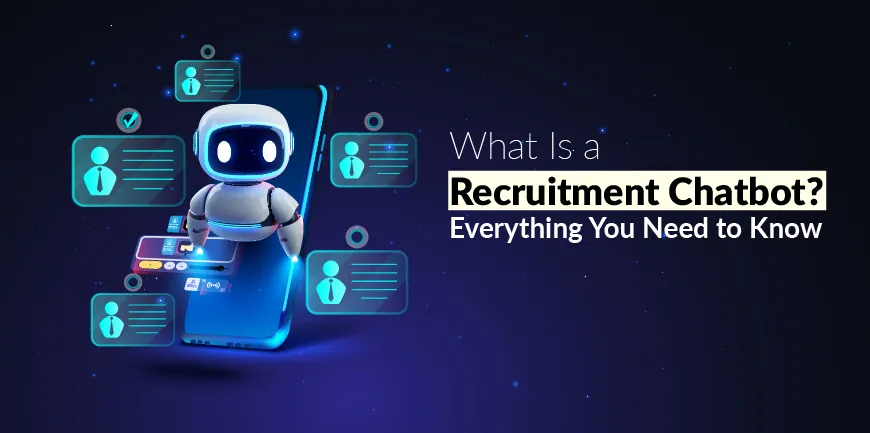
Driving Efficiency in Recruitment & HR with Digital Innovation
28/08/2025
How AI is Helping Fill Skilled Trade Gaps in the Engineering Sector?
02/09/2025Candidates in today’s fast-paced era are far-sighted, and they yearn for self-development and career growth that can take them a long way. They get attracted to employers who promote a healthy and positive culture at work, fostering the professional and personal growth of employees.
Candidate Experience 2.0 poses as a game-changer in the dynamically progressing job market. Candidates focus on analysing employees before making decisions. It is a new era, and recruiters and businesses must gear up to make candidate experiences worthwhile.
As Jeff Bezos has said, “We see our candidates as guests to a party, and we are the hosts. It’s our job every day to make every important aspect of the candidate experience a little bit better.”
Why does Candidate Experience Leave a Mark Today?
The recruitment process today is not a one-way street anymore; an employer is evaluated by a candidate as much as they assess job seekers. According to IBM, 78% of job seekers say the overall candidate experience they receive signals how a company values its people. A positive candidate experience increases the reapplication chances by 95%.
- In a competitive landscape, talent waits for no one; there is a continuous high demand for talent across sectors, hence a positive or poor candidate experience directly influences whether candidates will stay with you or switch to the next potential employer.
- The employer brand plays a vital role in improving or deterring candidate experiences. The moment a candidate begins their recruitment journey, they are keen on knowing and learning about the company environment, values, traditions, etc.
- Recruitment cycles that are respectful, smooth, and transparent from the get-go earn instant trust of candidates. Similarly, a poor, erratic, and disorganized journey leaves a negative impact.
- With social media and online platforms gaining momentum, news spreads like wildfire, and the reputation of businesses depends on the feedback shared online by candidates. Employer advocacy plays a crucial part in maintaining the reputation of organizations.
- Creation of a strong talent bank is highly likely if the candidate’s experiences are welcoming. A candidate who gets rejected due to a certain reason might recommend an organization to others based on a satisfactory hiring journey.
- A candidate’s experience can be gauged from initial interactions and does not have to wait until after onboarding. A candidate who is valued and heard from the inception is likely to accept the offer and would likely stay long term.
Factors that Define Candidate Experience 2.0
Let us check out the elements that define Candidate Experience 2.0 :
- Transparency- Employers must design uncomplicated timelines, trustworthy job descriptions, and clearly present pay structures, portraying an honest picture of the organization.
- Speed- Recruiters and businesses must try to expedite processes by communicating with candidates regularly, responding to queries, and providing continuous feedback.
- Fair Processes- The execution of bias-free procedures must be the top priority of companies, and they must craft structures enabled by technology to make skill assessments, interviews fair and square.
- Personalized approach- A customized way of communication with candidates is important. This creates a feeling of respect and belonging amongst candidates if the communication caters to their career choices and career growth.
- Human approach – An empathetic and humane way of communicating with candidates can earn their trust. The candidates seek respect and transparent interactions.
Various Touchpoints of a Recruitment Journey
Employers and recruiters engineer the recruitment journey, considering various stages where candidate experience 2.0 matters:
- The first stage is when an organization post required roles and job positions on various platforms. This is when a candidate will begin engaging themselves if they feel that the postings are appealing.
- The second important stage is for employers to create a smooth and simple application system with user-friendly application forms, mobile-first portals, etc, to make the application process convenient for candidates.
- The next stage is the initial evaluations and the final interviews. The framework of these assessment structures must be robust, with clear communication channels.
- Next comes the part where the final decision is made by employers, and a candidate is selected. It is not just about selecting candidates but ensuring that the process of extending an offer is reasonable and fair, with efficient communication systems in place.
- Finally, a flawless onboarding process that will integrate a candidate into the work system smoothly. A good employer or recruiter will not disappoint rejected candidates as well, and lay out opportunities to keep them connected.
Way Forward for Employers to Win Talent Today
It is 2025, and we all know the saying Where there is a will, there is a way. This proverb holds for today’s employers, and they can win top talent if they keep a few factors in mind. Let us check out some of the factors:
Automation and Human Intervention
Candidates get frustrated when they don’t hear from hiring managers and employers about their application status.
To trigger smart and swift communication, employers must start automating their systems with advanced tech tools.
However, along with automation, there must be human conversations that will help create connections.
Measuring Experiences
Employers must measure candidate experiences like commodities. They must conduct surveys and assessments at various stages to decipher what a candidate feels or if they want to understand a candidate’s intention.
Implementing Inclusive Designs
A recruitment journey from its inception must be crafted by keeping an inclusive mindset. Every step of the process must have a set accessibility standard.
No candidate should feel left out or disrespected. From applications to interviews, the goal is to open doors for all candidates, irrespective of their backgrounds.
Offer Closure
Sometimes, employers feel that the employment journey is over after the onboarding is done.
This is a wrong notion as it might leave candidates who are not selected at bay and dejected.
A rejection can be converted into a positive situation if rejected candidates receive feedback on time.
They will feel valued and can talk well about the organization, enhancing the employer brand.
Key Takeaways: Candidate Experience 2.0
| Theme | Key Insights | Impact on Employers & Candidates |
| Why It Matters | Candidate experience reflects how much an organization values people; poor experiences harm the employer brand and talent pipeline. | Positive journeys boost reapplications and strengthen trust; negative ones spread quickly online. |
| Transparency | Honest job descriptions, clear timelines, and visible pay structures set realistic expectations. | Builds credibility and reduces early drop-offs. |
| Speed | Regular updates, fast scheduling, and timely decisions keep candidates engaged. | Prevents talent loss to faster-moving competitors. |
| Fair Processes | Bias-free assessments, structured interviews, and tech-enabled evaluation methods. | Promotes equity and widens the talent pool. |
| Personalization | Tailored communication aligned with career goals and candidate preferences. | Creates a sense of respect, belonging, and engagement. |
| Human Touch | Empathetic conversations alongside automation. | Balances efficiency with connection and trust. |
| Inclusivity | Accessibility is built into applications, assessments, and interviews. | Ensures no candidate feels excluded; strengthens diversity hiring. |
| Closing the Journey | Timely, respectful rejections with constructive feedback. | Leaves candidates feeling valued, turning even rejected ones into advocates. |
| Way Forward 2025 | Combine automation, inclusivity, measurement, and empathy in recruitment journeys. | Employers win top talent, improve brand reputation, and build lasting relationships. |
In 2025, there is no room for any slack, as the market is competitive at its best. Employers must think of Candidate Experience 2.0 as a business prerogative, investing in the latest tools and methods to accelerate hiring journeys and, in the process, strengthen their employer brand by appealing to candidates across locations.
The future of hiring is reliant on many factors, and Candidate Experience 2.0 serves as one of the most critical factors.
It is now or never for Employers, and they need to act fast and intelligently, treating hiring journeys not just as mere transactions but as a chance to build long-term and strong relationships that thrive on trust, credibility, and transparency.
Contact Us For Business Enquiry

Amit Saproo
Amit Saproo is the Head of Operations at ALP Consulting with nearly 17 years of experience in Executive Search, RPO, Leadership, and IT & Engineering recruitment. He leads nationwide recruitment programs across Technology, BFSI, and R&D domains, driving strategic hiring solutions for diverse client needs. Amit excels in building and managing high-performance teams that deliver scalable, end-to-end recruitment and consulting services.




